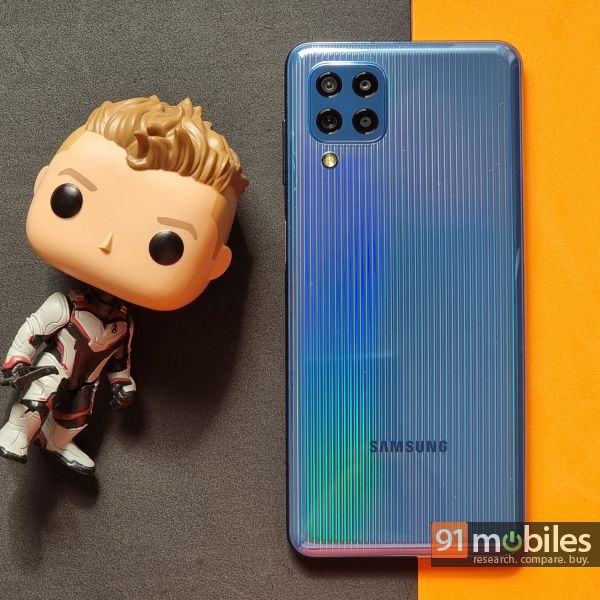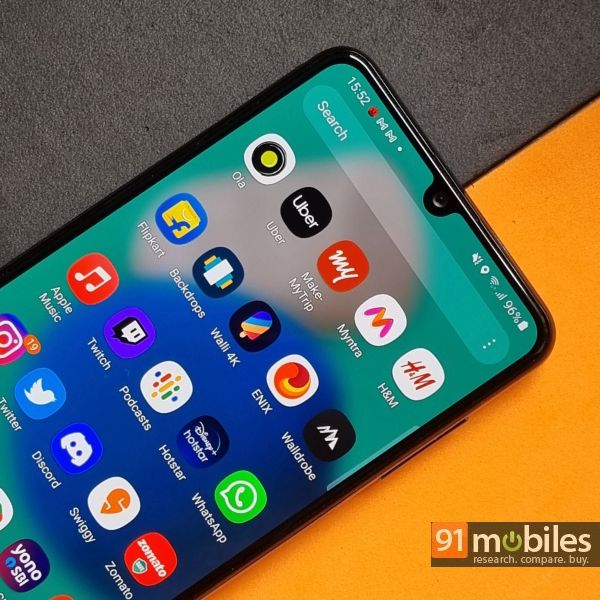Review Summary
Expert Rating
Samsung is best known for its innovative, high-end devices but the Korean giant is no stranger to the affordable smartphone segment either. In fact, the company’s M-series has for long, gone toe-to-toe with popular Chinese OEMs and at times, has even bested the competition.

Verdict
The Galaxy M32 isn’t the best in terms of pure performance in its price segment, and the lack of HD support for streaming services is another niggle. However, the device scores high in various other aspects, such as design, the capabilities of its primary camera, display quality and battery life. For its asking price, the Galaxy M32 does appear to be a compelling choice in its segment, not just for Samsung loyalists, but also for others who desire a reliable daily driver.
Design
The Samsung Galaxy M32 features an all-plastic build, but don’t let that fool you into thinking that the device looks bad or feels cheap. On the contrary, the M32 is among the better-looking devices in the segment and the smartphone’s good looks can be accredited to the unique gradient finish on its back which, oddly enough, reminds me of a disco ball. The coating employs shimmering lines that run across the length of the smartphone and exhibit different hues whenever light impacts them at an angle. Don’t worry though, the finish isn’t too out there and my blue colour review unit of the M32 looked equal parts elegant and equal parts flashy.


The smartphone also features a speedy capacitive fingerprint sensor towards the side, which was easy to reach with my thumb – colour me impressed, Samsung. The face unlock software did a good job during the day too, though the accuracy was a bit low in dimly-lit environments. The device ships with a tactile volume rocker above the fingerprint sensor / power button. The handset also employs a USB Type-C port at the bottom, which can be found sandwiched between the 3.5mm headphone jack and the phone’s mono speaker grille.

Of course, you’d want your new phone to be durable too. To that note, Samsung bundles a plastic TPU case with the handset and has even garnished the front of the phone with Corning’s Gorilla Glass v5 display protection. Consequently, the phone should come out unscathed if you accidentally drop it on the floor.
Display
The Samsung Galaxy M32 offers a fantastic screen for the price, albeit with some caveats. But before I get into that, you should know that the device ships with a 6.4-inch, sAMOLED FHD panel with a refresh rate of 90Hz. The display gets adequately bright at 800nits too and as prefaced previously, comes with a layer of Corning’s Gorilla Glass v5 on top. Spec-wise, the M32’s display is among the best in its segment, but, techno mumbo-jumbo aside, leaves a bit to be desired.

Now, let me be clear – the issues I encountered with the phone’s viewing experience weren’t inherently due to its display, but more so owing to the supporting components. To that note, while the display offers a 90Hz refresh rate, I found the animations a tad stuttery – clearly, the Helio G80 SoC had a tough time running everything smoothly. Furthermore, despite offering a high-quality sAMOLED panel, the M32 cannot stream content in HD or HDR from OTT services like Netflix and Amazon Prime. That’s quite surprising, and I can’t really fault the screen here – after all, the panel offers excellent viewing angles and the punch hole notch isn’t too obtrusive either.

What I’m trying to get at is that the panel checks all the right boxes, but either the phone doesn’t come with the appropriate certification, or the SoC is restricting high-quality playback. Of course, this shouldn’t matter to you – the end consumer – and it’s solely up to the brand to ensure that the display is truly the best in its segment. Unfortunately, while the M32’s panel has all the makings of one, it’s not quite there just yet.
Cameras
On to the cameras and here, the Samsung Galaxy M32 ships with a 64MP main sensor that works alongside an 8MP wide-angle lens, a 2MP macro sensor and a 2MP depth sensor. For selfies, the device gets a 20MP front camera. Here’s a summary of my experience with the camera across different scenarios –- The Samsung Galaxy M32’s primary 64MP sensor outputs quality images during the day. The photos show vibrant colours, especially with the scene optimiser enabled and are plush with details. Of course, the post-processing could’ve been better as the images appear oversharpened at closer crop.
![]()
- Furthermore, in a bid to bring out more details from the shadows, the device also introduces noise in the composition. Case in point, the daylight shot of my apartment complex wherein, you can see slight grainy-ness around the brick fence. I also noticed that the phone wouldn’t automatically adjust the exposure and I had to tap on the viewfinder before clicking a photo.
- That said, I doubt buyers opting for the phone will have many complaints with the phone’s photo capabilities during the day. In fact, unlike some similarly-priced offerings, the M32 doesn’t blotch up the colour red, which is evident from the shot of the red flower wherein, you can make out the details in the petals clearly.
- The 64MP mode, on the other hand, could’ve benefitted from some software tweaks. I wasn’t the biggest fan of the dynamic range in the high-res photos and there were noticeable instances of highlight clipping too, which can be seen if you pan towards the top right-hand side of the 64MP shot attached in the gallery. Here, you’ll notice that the smartphone has struggled to resolve the blue colour of the sky.
- Moving on, shots taken from the assisting sensors were nothing to write home about. The macro images, for instance, appeared soft at a closer crop and the wide-angle images had little to no corner details. The same goes for the images clicked after the sun had set and even with the night mode enabled, the resulting photos still had a lot of noise. Also, I was expecting the phone to brighten up the scene and bring out more information from the darker parts of the shot but to no avail.
- Thankfully, selfies clicked with the phone looked stellar and the device managed to create a convincing blur effect around my face too. That said, I wouldn’t recommend the Galaxy M32 to budding videographers as the smartphone supports only 1080p 30 fps video recording.
Performance and Software
As I mentioned previously, the Galaxy M32 employs MediaTek’s Helio G80 SoC, which works alongside either 4GB or 6GB of RAM. Correspondingly, buyers will get either 64GB or 128GB of eMMC 5.1 storage. Now, having spent a good chunk of my time testing the phone, I can confirm that the smartphone cannot hold a candle to similarly-priced devices like the POCO X3 (review), or the Moto G40 Fusion (review), at least in terms of raw performance. The benchmark scores alone, pit the M32 below the competition, but that’s not to say that the M32 is slow.
Don’t get me wrong, I am not trying to sugarcoat the M32’s performance woes. In fact, while I can somewhat make a case for the phone’s processor, Samsung should’ve at least offered faster storage with the phone. Be it opening apps, launching games or even searching something in the settings menu, the M32 felt a bit sluggish. The same was evident from the smartphone’s AndroBench score wherein, the device outputted low sequential read and write speeds.

Software-wise, the Samsung Galaxy M32 features the company’s OneUI v3.1 on top of Android 11. The custom skin offers a handful of utilities, albeit ships with a ton of bloatware. Thankfully, you can uninstall most third-party apps and even declutter your phone’s built-in storage by removing Samsung’s own duplicate apps, the likes of which include Samsung Internet, etc. The device also comes with a slew of customisation features and be it choosing a new Always-on Display clock face, to a different system theme, you can do it all. I would’ve also liked to see support for third-party icons with the custom skin but, for the most part, the software experience on the Galaxy M32 is quite satisfactory.
Battery Life and Connectivity
The Samsung Galaxy M32 ships with a 6,000mAh cell which, coupled with the phone’s AMOLED screen, should comfortably see users through the end of a long workday. The downside is that the device takes awfully long to refuel completely. While the phone supports 25W charging, Samsung has included a 15W brick with the phone which took almost two hours and twenty minutes to charge the handset from 0 to 100 percent.

As for connectivity, the device comes with support for both 2.4GHz as well as 5GHz Wi-Fi networks. I also netted excellent download and upload speeds on my 4G Airtel Postpaid SIM in Delhi NCR, and the quality of calls relayed through the phone’s earpiece was to my liking as well. Unfortunately, the company confirmed that the M32 doesn’t support 4G Carrier Aggregation, which is a bummer.
Final Verdict
The Samsung Galaxy M32 starts at Rs 14,999 for the 4GB RAM variant, with the 6GB model retailing for Rs 15,999 in India. Going by its spec sheet, the base variant of the smartphone comes across as a compelling buy, though the phone isn’t perfect. For one, the M32 isn’t the speediest device in its price segment, so if the occasional lag or stutter bothers you, you should look elsewhere. Moreover, while the phone offers a fantastic display and a beefy battery, the handset’s 15W adapter might leave buyers wanting more.

Those looking to snag the phone at full price might have a tough time justifying their purchase, especially when there are devices like the Redmi Note 10 Pro and Moto G40 Fusion with similar specs available at the same or lesser price points. But at its discounted price of under Rs 14K, the smartphone offers solid value. It should be worth a close, hard look, since it is a capable shooter and clicks stunning images during the day. Its design, nice display and long battery life should work in its favour as well.
Editor’s rating: 3.5 / 5
Pros:
- Good-looking design
- Long-lasting battery backup
- Stunning FHD+, 90Hz sAMOLED screen
- Capable 64MP sensor
Cons:
- Performance isn’t the best
- No HD/HDR streaming support on OTT services
- Assisting camera sensors click sub-par photos
- 15W bundled brick in the box
 | Rs. 13,399.00 | Go To Store |
 Samsung Galaxy M32 Samsung Galaxy M32 | vs |  Xiaomi Redmi Note 10 Pro Xiaomi Redmi Note 10 Pro |
 Samsung Galaxy M32 Samsung Galaxy M32 | vs |  Moto G40 Fusion Moto G40 Fusion |



























![[Exclusive] Samsung Galaxy M32 specifications revealed: 48MP quad cameras, 6,000mAh battery, and more Thumbnail](https://www.91-cdn.com/hub/wp-content/uploads/2021/06/samsung-galaxy-m32-image-feat.jpg?tr=h-110,q-100,pr-true)

